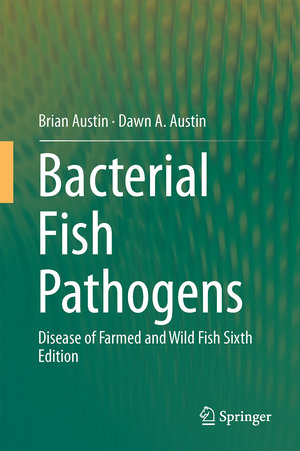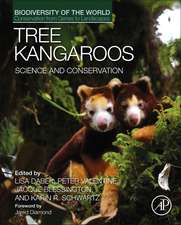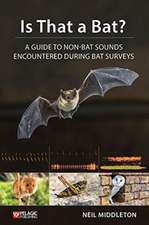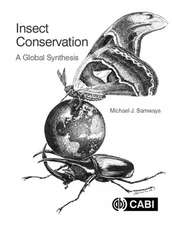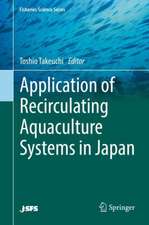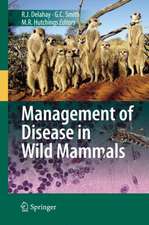Bacterial Fish Pathogens: Disease of Farmed and Wild Fish
Autor Brian Austin, Dawn A. Austinen Limba Engleză Hardback – 25 oct 2016
The book is primarily targeted at researcher workers, including postgraduate students, and diagnosticians. It is anticipated that the readership will include veterinary microbiologists, public health scientists and microbial ecologists.
| Toate formatele și edițiile | Preț | Express |
|---|---|---|
| Paperback (2) | 1235.25 lei 6-8 săpt. | |
| SPRINGER NETHERLANDS – 15 oct 2014 | 1235.25 lei 6-8 săpt. | |
| Springer International Publishing – 23 iun 2018 | 1475.19 lei 39-44 zile | |
| Hardback (2) | 1252.76 lei 6-8 săpt. | +125.54 lei 6-12 zile |
| Springer International Publishing – 25 oct 2016 | 1500.16 lei 18-23 zile | +125.54 lei 6-12 zile |
| SPRINGER NETHERLANDS – sep 2012 | 1252.76 lei 6-8 săpt. |
Preț: 1500.16 lei
Preț vechi: 1973.90 lei
-24% Nou
Puncte Express: 2250
Preț estimativ în valută:
287.07€ • 301.86$ • 237.19£
287.07€ • 301.86$ • 237.19£
Carte disponibilă
Livrare economică 24-29 martie
Livrare express 12-18 martie pentru 135.53 lei
Preluare comenzi: 021 569.72.76
Specificații
ISBN-13: 9783319326733
ISBN-10: 3319326732
Pagini: 645
Ilustrații: XXXV, 732 p. 48 illus. in color.
Dimensiuni: 155 x 235 x 44 mm
Greutate: 1.44 kg
Ediția:6th ed. 2016
Editura: Springer International Publishing
Colecția Springer
Locul publicării:Cham, Switzerland
ISBN-10: 3319326732
Pagini: 645
Ilustrații: XXXV, 732 p. 48 illus. in color.
Dimensiuni: 155 x 235 x 44 mm
Greutate: 1.44 kg
Ediția:6th ed. 2016
Editura: Springer International Publishing
Colecția Springer
Locul publicării:Cham, Switzerland
Cuprins
1. Introduction.- 2. Gram-positive bacteria (anaerobes and lactic acid bacteria’).- 3. Aerobic Gram-positive rods and cocci.- 4. Aeromonadaceae representatives (motile aeromonads).- 5. Aeromonadaceae representative (Aeromonas salmonicida).- 6. Enterobacteriaceae representatives.- 7. Flavobacteria and cytophagas.- 8.Francisellaceae representatives.- 9. Pseudomonads.- 10.- Vibrios.- 11. Miscellaneous pathogens.- 12. Isolation/detection.- 13.- Diagnosis.- 14. Control.- 15. Conclusions.
Recenzii
“The purpose is to provide up-to-date information on emerging technology available for pathogen identification in farm-raised fish. … This book clearly meets their objectives in defining and describing the bacterial pathogens of fish. The audience is aquatic microbiologists. Any investigator could learn and immediately use the techniques described in this book. … This book presents updates on the exploding technology available for pathogen identification.” (Dennis D. French, Doody's Book Reviews, February, 2017)
Notă biografică
Brian Austin is Professor Emeritus of Microbiology at the University of Stirling. From 1975-78 he was Research Associate at the University of Maryland, USA, and from 1978-84 was Head of Bacteriology at the Fish Diseases Laboratory in Weymouth, U.K. He joined Heriot-Watt University as a Lecturer in Aquatic Microbiology in 1984, was promoted to Reader in 1989, and to Professor in 1992, before moving to the University of Stirling in 2009 as Director of the Institute of Aquaculture and Professor of Microbiology. At Heriot-Watt University, he held various positions including, Head of Department, Head of School, and Dean of the University. Professor Austin gained a B.Sc. (1972) in Microbiology, a Ph.D. (1975) also in Microbiology, both from the University of Newcastle upon Tyne, and a D.Sc. (1992) from Heriot-Watt University. He was elected FHEA, FRSA and Fellow of the American Academy of Microbiology, and until retirement was a member of the American Society of Microbiology, Society of Applied Bacteriology, Society of General Microbiology, European Association of Fish Pathologists, and was President of the Bergey’s International Society for Microbial Systematics. He has written previous books on bacterial taxonomy, marine microbiology, methods in aquatic bacteriology, methods for the microbiological examination of fish and shellfish, and pathogens in the environment.
Dawn Austin is a Research Associate at Heriot-Watt University, a position she has held since 1986. Prior to this she was Research Assistant at the University of Maryland (1977-79), Lecturer in Microbiology, University of Surrey (1983-84), and Research Fellow of the Freshwater Biological Association, The River Laboratory, Dorset (1984-85). Dr. Austin gained a B.S. (1974) from City College, The City University, New York; an M.S. (1979) and a Ph.D. (1982) both from the University of Maryland.
Dawn Austin is a Research Associate at Heriot-Watt University, a position she has held since 1986. Prior to this she was Research Assistant at the University of Maryland (1977-79), Lecturer in Microbiology, University of Surrey (1983-84), and Research Fellow of the Freshwater Biological Association, The River Laboratory, Dorset (1984-85). Dr. Austin gained a B.S. (1974) from City College, The City University, New York; an M.S. (1979) and a Ph.D. (1982) both from the University of Maryland.
Textul de pe ultima copertă
This book puts emphasis on the isolation, taxonomy, diagnosis (phenotypic, serology and molecular biology), epizootiology, pathogenicity mechanisms, and methods of disease control (by vaccination, immunostimulation, probiotics, prebiotics, plant products, and antimicrobial compounds. Co-infections, which are attributed to more than one microbial species have been discussed. Shortcomings in knowledge have been highlighted. This sixth edition is the successor to the original version, first published in 1987, and which fills the need for an up-to-date comprehensive text on the biological aspects of the bacterial taxa which cause disease in finfish.
The book is primarily targeted at researcher workers, including postgraduate students, and diagnosticians. It is anticipated that the readership will include veterinary microbiologists, public health scientists and microbial ecologists.
The book is primarily targeted at researcher workers, including postgraduate students, and diagnosticians. It is anticipated that the readership will include veterinary microbiologists, public health scientists and microbial ecologists.
Caracteristici
Describes all the bacterial pathogens of farmed and wild fish Discusses methods of isolation, diagnosis and control Highlights shortcomings in knowledge and control strategies of the fish diseases Updated version of the current fifth edition
